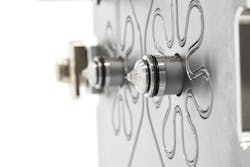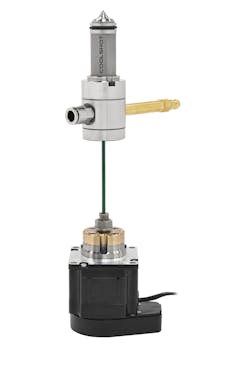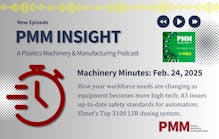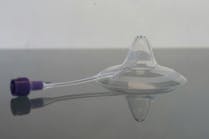Ewikon taps hot-runner technology for its Coolshot LSR system
Much of the technology behind Ewikon’s new Coolshot electric valve-gate cold-runner system for liquid silicone rubber (LSR) has been adapted from the company’s electric hot-runner valve-gate developments. The result yields a plethora of benefits, including reduced set-up time, balanced flow, shorter cycle times and the elimination of sprue waste, since parts are direct-gated, said Managing Director Stefan Eimeke.
The LSR market is small, but Ewikon sees continuing growth in many areas: medical, automotive, electronics, sports and recreational products, household goods and clothing accessories, among others.
The Coolshot valve-gate system, Eimeke said, is suitable for a range of parts and part sizes and offers greater advantages in process control, economy and repeatable quality than competitive pneumatic and hydraulic cold-runner systems.
The electric valve-gate system allows minute control of valve-pin movements and consequently the ability to rapidly balance LSR cavity filling. “This Coolshot system offers customers a cold-runner solution that considerably optimizes LSR processing, and which can be installed as a cold mold half for convenient installation and setup,” he said.
LSR can be difficult to process when it comes to flow balancing. Eimeke said this is primarily because it is less viscous than thermoplastics, so deviations in flow rate and cavity-fill volume can result.
LSR batches that would require new flow adjustments and pin positions.
The controller’s ability to monitor pin positions also means that if deviations occur during processing that affect pin movement — for example, a buildup of crosslinked LSR in the gate area — a warning alert will display.
There is one Coolshot nozzle size; the pitch is 56mm. Ewikon specifies different materials and geometries for the nozzle tips. The ability to select a tip for each application allows the company to “perfectly adapt the temperature profile in the gate area to the required mold temperature, which varies depending on the type of LSR that is being processed,” Eimeke said. Specifying the right tip geometry and tip material for different types of LSR helps maintain the ideal temperature profile and achieve the shortest cycle time.
The Coolshot system also is equipped with coil heaters that Eimeke said have “decisive advantages” over the rigid heater rods that are common in many cold-runner molds. Heaters are necessary for the rapid and homogeneous crosslinking of some types of LSR. Because coil heaters are flexible, they allow the heating layout to conform to specific mold designs, especially in the gate area.
Among the advantages that Eimeke cited for the system are short lead times compared with many other cold-runner systems. “We can deliver a Coolshot runner system in eight to 10 weeks,” he said. Coolshot also is competitively priced.
Eimeke said that, unlike some other suppliers, Ewikon only builds the cold runner and not the mold. “We are not competing with our mold-builder customers.”
Pat Toensmeier, contributor
Contact:
Ewikon Molding Technologies Inc. Rockford, Ill., 815-874-7270,








